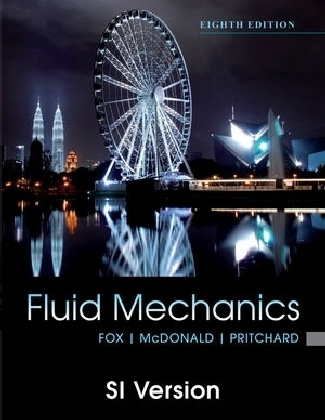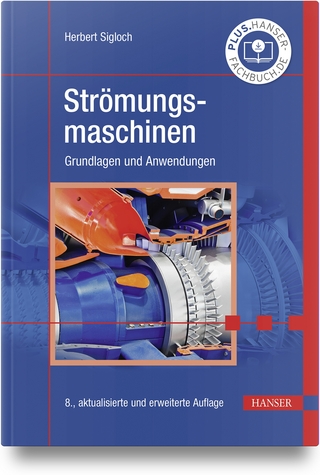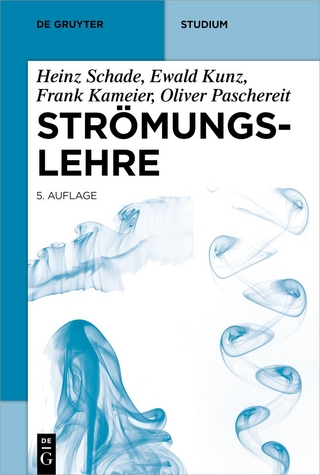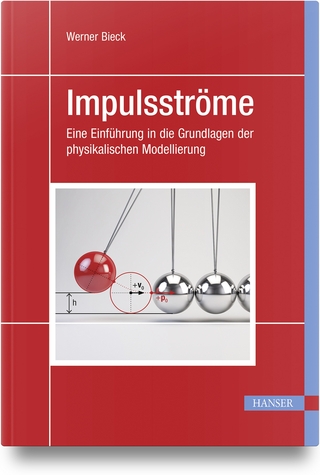
Fox and Mcdonald's Introduction to Fluid Mechanics, 8th Edition International Student Version
John Wiley & Sons Inc (Verlag)
978-1-118-02641-0 (ISBN)
- Titel ist leider vergriffen;
keine Neuauflage - Artikel merken
CHAPTER 1 INTRODUCTION /1 1.1 Note to Students /3 1.2 Scope of Fluid Mechanics /4 1.3 Definition of a Fluid /4 1.4 Basic Equations /5 1.5 Methods of Analysis /6 System and Control Volume /7 Differential versus Integral Approach /8 Methods of Description /9 1.6 Dimensions and Units /11 Systems of Dimensions /11 Systems of Units /11 Preferred Systems of Units /13 Dimensional Consistency and Engineering Equations /14 1.7 Analysis of Experimental Error /15 1.8 Summary /16 Problems /17 CHAPTER 2 FUNDAMENTAL CONCEPTS /20 2.1 Fluid as a Continuum /21 2.2 Velocity Field /23 One-, Two-, and Three-Dimensional Flows /24 Timelines, Pathlines, Streaklines, and Streamlines /25 2.3 Stress Field /29 2.4 Viscosity /31 Newtonian Fluid /32 Non-Newtonian Fluids /34 2.5 Surface Tension /36 2.6 Description and Classification of Fluid Motions /38 Viscous and Inviscid Flows /38 Laminar and Turbulent Flows /41 Compressible and Incompressible Flows /42 Internal and External Flows /43 2.7 Summary and Useful Equations /44 References /46 Problems /46 CHAPTER 3 FLUID STATICS /55 3.1 The Basic Equation of Fluid Statics /56 3.2 The Standard Atmosphere /60 3.3 Pressure Variation in a Static Fluid /61 Incompressible Liquids: Manometers /61 Gases /66 3.4 Hydraulic Systems /69 3.5 Hydrostatic Force on Submerged Surfaces /69 Hydrostatic Force on a Plane Submerged Surface /69 Hydrostatic Force on a Curved Submerged Surface /76 *3.6 Buoyancy and Stability /80 3.7 Fluids in Rigid-Body Motion (on the Web) /W-1 3.8 Summary and Useful Equations /83 References /84 Problems /84 CHAPTER 4 BASIC EQUATIONS IN INTEGRAL FORM FOR A CONTROL VOLUME /96 4.1 Basic Laws for a System /98 Conservation of Mass /98 Newton s Second Law /98 The Angular-Momentum Principle /99 The First Law of Thermodynamics /99 The Second Law of Thermodynamics /99 4.2 Relation of System Derivatives to the Control Volume Formulation /100 Derivation /101 Physical Interpretation /103 4.3 Conservation of Mass /104 Special Cases /105 4.4 Momentum Equation for Inertial Control Volume /110 *Differential Control Volume Analysis /122 Control Volume Moving with Constant Velocity /126 4.5 Momentum Equation for Control Volume with Rectilinear Acceleration /128 4.6 Momentum Equation for Control Volume with Arbitrary Acceleration (on the Web) /W-6 *4.7 The Angular-Momentum Principle /135 Equation for Fixed Control Volume /135 Equation for Rotating Control Volume (on the Web) /W-11 4.8 The First Law of Thermodynamics /139 Rate of Work Done by a Control Volume /140 Control Volume Equation /142 4.9 The Second Law of Thermodynamics /146 4.10 Summary and Useful Equations /147 Problems /149 CHAPTER 5 INTRODUCTION TO DIFFERENTIAL ANALYSIS OF FLUID MOTION /171 5.1 Conservation of Mass /172 Rectangular Coordinate System /173 Cylindrical Coordinate System /177 *5.2 Stream Function for Two-Dimensional Incompressible Flow /180 5.3 Motion of a Fluid Particle (Kinematics) /184 Fluid Translation: Acceleration of a Fluid Particle in a Velocity Field /185 Fluid Rotation /190 Fluid Deformation /194 5.4 Momentum Equation /197 Forces Acting on a Fluid Particle /198 Differential Momentum Equation /199 Newtonian Fluid: Navier-Stokes Equations /199 *5.5 Introduction to Computational Fluid Dynamics /208 The Need for CFD /208 Applications of CFD /209 Some Basic CFD/Numerical Methods Using a Spreadsheet /210 The Strategy of CFD /215 Discretization Using the Finite-Difference Method /216 Assembly of Discrete System and Application of Boundary Conditions /217 Solution of Discrete System /218 Grid Convergence /219 Dealing with Nonlinearity /220 Direct and Iterative Solvers /221 Iterative Convergence /222 Concluding Remarks /223 5.6 Summary and Useful Equations /224 References /226 Problems /226 CHAPTER 6 INCOMPRESSIBLE INVISCID FLOW /235 6.1 Momentum Equation for Frictionless Flow: Euler s Equation /237 6.2 Euler s Equations in Streamline Coordinates /238 6.3 Bernoulli Equation: Integration of Euler s Equation Along a Streamline for Steady Flow /241 *Derivation Using Streamline Coordinates /241 *Derivation Using Rectangular Coordinates /242 Static, Stagnation, and Dynamic Pressures /244 Applications /247 Cautions on Use of the Bernoulli Equation /252 6.4 The Bernoulli Equation Interpreted as an Energy Equation /253 6.5 Energy Grade Line and Hydraulic Grade Line /257 *6.6 Unsteady Bernoulli Equation: Integration of Euler s Equation Along a Streamline (on the Web) /W-16 *6.7 Irrotational Flow /259 Bernoulli Equation Applied to Irrotational Flow /260 Velocity Potential /261 Stream Function and Velocity Potential for Two-Dimensional, Irrotational, Incompressible Flow: Laplace s Equation /262 Elementary Plane Flows /264 Superposition of Elementary Plane Flows /267 6.8 Summary and Useful Equations /276 References /279 Problems /279 CHAPTER 7 DIMENSIONAL ANALYSIS AND SIMILITUDE /290 7.1 Nondimensionalizing the Basic Differential Equations /292 7.2 Nature of Dimensional Analysis /294 7.3 Buckingham Pi Theorem /296 7.4 Determining the Groups /297 7.5 Significant Dimensionless Groups in Fluid Mechanics /303 7.6 Flow Similarity and Model Studies /305 Incomplete Similarity /308 Scaling with Multiple Dependent Parameters /314 Comments on Model Testing /317 7.7 Summary and Useful Equations /318 References /319 Problems /320 CHAPTER 8 INTERNAL INCOMPRESSIBLE VISCOUS FLOW /328 8.1 Introduction /330 Laminar versus Turbulent Flow /330 The Entrance Region /331 PART A. FULLY DEVELOPED LAMINAR FLOW /332 8.2 Fully Developed Laminar Flow Between Infinite Parallel Plates /332 Both Plates Stationary /332 Upper Plate Moving with Constant Speed, U /338 8.3 Fully Developed Laminar Flow in a Pipe /344 PART B. FLOW IN PIPES AND DUCTS /348 8.4 Shear Stress Distribution in Fully Developed Pipe Flow /349 8.5 Turbulent Velocity Profiles in Fully Developed Pipe Flow /351 8.6 Energy Considerations in Pipe Flow /353 Kinetic Energy Coefficient /355 Head Loss /355 8.7 Calculation of Head Loss /357 Major Losses: Friction Factor /357 Minor Losses /361 Pumps, Fans, and Blowers in Fluid Systems /367 Noncircular Ducts /368 8.8 Solution of Pipe Flow Problems /369 Single-Path Systems /370 *Multiple-Path Systems /383 PART C. FLOW MEASUREMENT /387 8.9 Direct Methods /387 8.10 Restriction Flow Meters for Internal Flows /387 The Orifice Plate /391 The Flow Nozzle /391 The Venturi /393 The Laminar Flow Element /394 8.11 Linear Flow Meters /397 8.12 Traversing Methods /399 8.13 Summary and Useful Equations /400 References /402 Problems /403 CHAPTER 9 EXTERNAL INCOMPRESSIBLE VISCOUS FLOW /421 PART A. BOUNDARY LAYERS /423 9.1 The Boundary-Layer Concept /423 9.2 Boundary-Layer Thicknesses /425 9.3 Laminar Flat-Plate Boundary Layer: Exact Solution (on the Web) /W-19 9.4 Momentum Integral Equation /428 9.5 Use of the Momentum Integral Equation for Flow with Zero Pressure Gradient /433 Laminar Flow /434 Turbulent Flow /439 Summary of Results for Boundary-Layer Flow with Zero Pressure Gradient /441 9.6 Pressure Gradients in Boundary-Layer Flow /442 PART B. FLUID FLOW ABOUT IMMERSED BODIES /445 9.7 Drag /445 Pure Friction Drag: Flow over a Flat Plate Parallel to the Flow /446 Pure Pressure Drag: Flow over a Flat Plate Normal to the Flow /450 Friction and Pressure Drag: Flow over a Sphere and Cylinder /450 Streamlining /456 9.8 Lift /459 9.9 Summary and Useful Equations /474 References /477 Problems /478 CHAPTER 10 FLUID MACHINERY /492 10.1 Introduction and Classification of Fluid Machines /494 Machines for Doing Work on a Fluid /494 Machines for Extracting Work (Power) from a Fluid /496 Scope of Coverage /498 10.2 Turbomachinery Analysis /499 The Angular-Momentum Principle: The Euler Turbomachine Equation /499 Velocity Diagrams /501 Performance Hydraulic Power /504 Dimensional Analysis and Specific Speed /505 10.3 Pumps, Fans, and Blowers /510 Application of Euler Turbomachine Equation to Centrifugal Pumps /510 Application of the Euler Equation to Axial Flow Pumps and Fans /512 Performance Characteristics /516 Similarity Rules /522 Cavitation and Net Positive Suction Head /526 Pump Selection: Applications to Fluid Systems /529 Blowers and Fans /541 10.4 Positive Displacement Pumps /548 10.5 Hydraulic Turbines /552 Hydraulic Turbine Theory /552 Performance Characteristics for Hydraulic Turbines /554 Sizing Hydraulic Turbines for Fluid Systems /558 10.6 Propellers and Wind-Power Machines /562 Propellers /563 Wind-Power Machines /571 10.7 Compressible Flow Turbomachines /581 Application of the Energy Equation to a Compressible Flow Machine /581 Compressors /582 Compressible-Flow Turbines /586 10.8 Summary and Useful Equations /586 References /589 Problems /591 CHAPTER 11 FLOW IN OPEN CHANNELS /600 11.1 Basic Concepts and Definitions /603 Simplifying Assumptions /604 Channel Geometry /605 Speed of Surface Waves and the Froude Number /606 11.2 Energy Equation for Open-Channel Flows /610 Specific Energy /613 Critical Depth: Minimum Specific Energy /616 11.3 Localized Effect of Area Change (Frictionless Flow) /619 Flow over a Bump /620 11.4 The Hydraulic Jump /625 Depth Increase Across a Hydraulic Jump /627 Head Loss Across a Hydraulic Jump /628 11.5 Steady Uniform Flow /631 The Manning Equation for Uniform Flow /633 Energy Equation for Uniform Flow /639 Optimum Channel Cross Section /640 11.6 Flow with Gradually Varying Depth /641 Calculation of Surface Profiles /644 11.7 Discharge Measurement Using Weirs /646 Suppressed Rectangular Weir /646 Contracted Rectangular Weirs /647 Triangular Weir /648 Broad-Crested Weir /648 11.8 Summary and Useful Equations /650 References /652 Problems /653 CHAPTER 12 INTRODUCTION TO COMPRESSIBLE FLOW /657 12.1 Review of Thermodynamics /659 12.2 Propagation of Sound Waves /665 Speed of Sound /665 Types of Flow The Mach Cone /670 12.3 Reference State: Local Isentropic Stagnation Properties /673 Local Isentropic Stagnation Properties for the Flow of an Ideal Gas /674 12.4 Critical Conditions /681 12.5 Summary and Useful Equations /681 References /683 Problems /683 CHAPTER 13 COMPRESSIBLE FLOW /689 13.1 Basic Equations for One-Dimensional Compressible Flow /691 13.2 Isentropic Flow of an Ideal Gas: Area Variation /694 Subsonic Flow, M , 1 /697 Supersonic Flow, M . 1 /697 Sonic Flow, M 5 1 /698 Reference Stagnation and Critical Conditions for Isentropic Flow of an Ideal Gas /699 Isentropic Flow in a Converging Nozzle /704 Isentropic Flow in a Converging-Diverging Nozzle /709 13.3 Normal Shocks /715 Basic Equations for a Normal Shock /716 Fanno and Rayleigh Interpretation of Normal Shock /718 Normal-Shock Flow Functions for One-Dimensional Flow of an Ideal Gas /719 13.4 Supersonic Channel Flow with Shocks /724 Flow in a Converging-Diverging Nozzle /724 Supersonic Diffuser (on the Web) /W-24 Supersonic Wind Tunnel Operation (on the Web) /W-25 Supersonic Flow with Friction in a Constant-Area Channel (on the Web) /W-26 Supersonic Flow with Heat Addition in a Constant-Area Channel (on the Web) /W-26 13.5 Flow in a Constant-Area Duct with Friction /727 Basic Equations for Adiabatic Flow /727 Adiabatic Flow: The Fanno Line /728 Fanno-Line Flow Functions for One-Dimensional Flow of an Ideal Gas /732 Isothermal Flow (on the Web) /W-29 13.6 Frictionless Flow in a Constant-Area Duct with Heat Exchange /740 Basic Equations for Flow with Heat Exchange /740 The Rayleigh Line /741 Rayleigh-Line Flow Functions for One-Dimensional Flow of an Ideal Gas /746 13.7 Oblique Shocks and Expansion Waves /750 Oblique Shocks /750 Isentropic Expansion Waves /759 13.8 Summary and Useful Equations /768 References /771 Problems /772 APPENDIX A FLUID PROPERTY DATA /785 APPENDIX B EQUATIONS OF MOTION IN CYLINDRICAL COORDINATES /796 APPENDIX C VIDEOS FOR FLUID MECHANICS /798 APPENDIX D SELECTED PERFORMANCE CURVES FOR PUMPS AND FANS /801 APPENDIX E FLOW FUNCTIONS FOR COMPUTATION OF COMPRESSIBLE FLOW /816 APPENDIX F ANALYSIS OF EXPERIMENTAL UNCERTAINTY /827 APPENDIX G SI UNITS, PREFIXES, AND CONVERSION FACTORS /834 APPENDIX H A BRIEF REVIEW OF MICROSOFT EXCEL (ON THE WEB) /W-33 Answers to Selected Problems /836 Index /865
| Verlagsort | New York |
|---|---|
| Sprache | englisch |
| Maße | 217 x 277 mm |
| Gewicht | 2 g |
| Themenwelt | Naturwissenschaften ► Physik / Astronomie ► Strömungsmechanik |
| Technik ► Bauwesen | |
| Technik ► Maschinenbau | |
| ISBN-10 | 1-118-02641-1 / 1118026411 |
| ISBN-13 | 978-1-118-02641-0 / 9781118026410 |
| Zustand | Neuware |
| Informationen gemäß Produktsicherheitsverordnung (GPSR) | |
| Haben Sie eine Frage zum Produkt? |
aus dem Bereich


